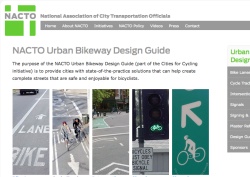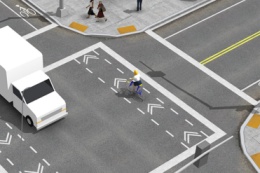
The National Association of City Transportation Officials (NACTO) — a coalition of 15 major U.S. cities — announced the official launch of their long-awaited Urban Bikeway Design Guide today. The guide is a product of NACTO’s ‘Cities for Cycling’ initiative that debuted back in December 2009.
In a press release, New York City Transportation Commissioner and NACTO President Janette Sadik-Khan encouraged transportation engineers in cities across America to adopt the standards, saying the new design guide, “gives planners and designers the tools they need to get to the next level.” “These guidelines represent the state of the art and should be adopted as the new standard around the country.”
“The Guide offers substantive guidance for cities and towns in the U.S., where existing guidance has failed to move forward as quickly as international experience and growth in cycling would warrant.”
The impetus behind the Guide came from city transportation officials (engineer Rob Burchfield and planner Mia Birk, both from Portland) who were frustrated that the Federal Highway Administration’s Manual on Uniform Traffic Control Devices (MUTCD) and the American Association of State Highway and Transportation Officials’ (AASHTO) Guide to the Development of Bicycle Facilities, both considered the bible for traffic engineers, had failed to keep pace with innovative bikeway treatments being successfully used in Europe and some American cities.
Tired of waiting for official adoption into those influential guide books, they decided to make their own.
[We explained this frustration and detailed the tension between city transportation officials and federal regulations in a post from November 2009 titled, Cities for Cycling could have huge impact on bikeway innovation.]

Here’s more about the Guide from NACTO:
“The Guide offers substantive guidance for cities and towns in the U.S., where existing guidance has failed to move forward as quickly as international experience and growth in cycling would warrant. The focus of the guide is on-street facilities, including cycle tracks, which provide protection for cyclists in high-traffic environments. Guide users can view detailed plan drawings, three dimension renderings of the designs, and pictures of actual projects from around the country.”
The importance of a new design guide that specifically focuses on urban bikeway treatments cannot be overstated. Without official standards to adopt and expert guidance to refer to, city transportation officials who wanted to install things like bike signals, bike-specific pavement markings, and separated bikeways, were at the mercy of FHWA and AASHTO guidelines — both of which have become dirty words to many planners and engineers in America’s largest cities. If you went against the federal standards, you’d be taking a big risk.
Back in 2009, Portland’s City Traffic Engineer Rob Burchfield said,
“The feds are in a tough position, they’re almost in a regulatory role instead of being in a leadership role… Their agenda is highways, but this is an urban issue, a city issue. We want them [the FHWA] to get out of the way.”
Back in August, we reported that the US Department of Transportation might consider interim approval of some of the design treatments detailed in this new guide. No update on that yet, but with this new guide being launched during the National Bike Summit and with NACTO President Janette Sadik-Khan set for a keynote speech Wednesday morning, we wouldn’t be surprised to hear an announcement on that front.
The launch of the Urban Bikeway Design Guide also comes with a companion website that includes 3-D drawings and photos and detailed design guidance showing how to implement the various treatments. You can browse the new guide at C4CGuide.org.
— The 15 cities that make up NACTO are Portland, New York City, Phoenix, San Francisco, Baltimore, Boston, Chicago, Detroit, Houston, Los Angeles, Minneapolis, Philadelphia, Seattle, and Washington D.C..

